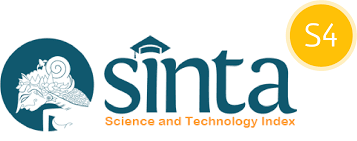Penerapan Data Mining untuk Mengcluster Data Penduduk Miskin Menggunakan Algoritma K-Means di Dusun Bagik Endep Sukamulia Timur
DOI:
https://doi.org/10.29408/jit.v4i1.2986Keywords:
Data Mining, K-Means Clustering, Proverty.Abstract
The occurrence of poverty in the community is caused by a condition of the economic inability of the head of the family to meet the primary / basic needs of his family, namely the need for clothing, food, shelter and education. The poor community itself can be found in almost every country, city and region, for example in one of the Bagik Endep hamlets of East Sukamulia Village. Based on these conditions, it is necessary to carry out clustering to assist the village government in grouping poor families, so that assistance can be distributed appropriately. By observing the above problems, Data Mining is needed to classify aid recipients using the K-Means method in clustering the poor. Where the K-Means Clustering Algorithm method aims to classify population data in the East Sukamulia region who are said to be classified as poor. The data used is data on the population of East Sukamulia in 2019, amounting to 200 data with 9 attributes, namely the name of the population, occupation, income / month, the number of children attending elementary school, the number of children attending junior high school, the number of children attending high school, the number of children attending college , the number of children who are not in school and the number of family members. Based on the results of tests carried out by applying the K-Means algorithm, the results obtained are Cluster 1 totaling 18 residents with the criteria of high economic population, Cluster 2 totaling 72 residents with moderate economic population criteria, and Cluster 3 totaling 110 residents with low economic population criteria. The K-Means method is expected to be able to assist the government of Sukamulia Timur Village in making decisions and finding the information needed to solve problems in recording the poor population accurately.
References
M. E. D. I. Purnomo, R. K. N, S. St, M. Kom, J. Sahertian, and S. Pd, “DATA MINING UNTUK OPTIMALISASI DISTRIBUSI PENJUALAN INDOMIE GORENG MENGGUNAKAN METODE CLUSTERING Oleh : Dibimbing oleh : SURAT PERNYATAAN ARTIKEL SKRIPSI TAHUN 2019,†2019.
J. I. Komputer, F. Matematika, D. A. N. Ilmu, and P. Alam, “PENERAPAN METODE CLUSTERING K-MEANS TERHADAP DOSEN BERDASARKAN PUBLIKASI,†2016.
I. Method, K. C. Based, S. Value, W. Interface, C. Study, and I. U. M. M. Magelang, “Penerapan Metode K-Means Untuk Clustering Mahasiswa Berdasarkan Nilai Akademik Dengan Weka Interface Studi Kasus Pada Jurusan Teknik Informatika UMM Magelang,†vol. 18, no. 1, pp. 76–82, 2015.
S. Kasus, T. Usaha, and M. Barabai, “PENERAPAN DATA MINING UNTUK KLASIFIKASI PRODUK MENGGUNAKAN ALGORTIMA K-MEANS,†vol. 2, no. 2, pp. 191–198, 2018.
A. M. Nur and B. Harianto, “Komparasi Algoritma SVM Dan SVM Berbasis PSO Dalam Menganalisis Kinerja Guru SMAN 3 Selong,†Infotek J. Inform. dan Teknol., vol. 2, no. 2, pp. 86–94, 2019.
F. Sembiring and S. Saepudin, “IMPLEMENTASI METODE K-MEANS DALAM PENGKLASTERAN DAERAH PUNGUTAN LIAR DI KABUPATEN SUKABUMI ( STUDI KASUS : DINAS KEPENDUDUKAN DAN PENCATATAN SIPIL ),†vol. 14, no. 1, pp. 40–47, 2020.
I. Nasution, A. P. Windarto, and M. Fauzan, “Penerapan Algoritma K-Means Dalam Pengelompokan Data Penduduk Miskin Menurut Provinsi,†vol. 2, no. 2, pp. 76–83, 2020.
L. Listiani, Y. H. Agustin, and M. Z. Ramdhani, “Implementasi algoritma k-means cluster untuk rekomendasi pekerjaan berdasarkan pengelompokkan data penduduk,†pp. 761–769, 2017.
T. U. Putri et al., “PENERAPAN DATA MINING UNTUK MENENTUKAN STRATEGI PENJUALAN PADA TOKO BUKU GRAMEDIA MENGGUNAKAN METODE CLUSTERING,†pp. 1–10.
R. W. Sari, A. Wanto, and A. P. Windarto, “IMPLEMENTASI RAPIDMINER DENGAN METODE K-MEANS ( STUDY KASUS : IMUNISASI CAMPAK PADA BALITA BERDASARKAN PROVINSI ),†vol. 2, pp. 224–230, 2018.
V. No, W. Purba, and W. Siawin, “IMPLEMENTASI DATA MINING UNTUK PENGELOMPOKKAN DAN PREDIKSI KARYAWAN YANG BERPOTENSI PHK DENGAN ALGORITMA K-MEANS CLUSTERING,†vol. 2, no. 2, 2019.
B. Classification, B. Badan, and L. P. Tangan, “PENENTUAN KLASIFIKASI STATUS GIZI ORANG DEWASA DENGAN ALGORITMA NAÃVE BAYES CLASSIFICATION ( STUDI KASUS PUSKESMAS JIKEN ),†pp. 1–10.
D. Safira, E. D. Lestari, M. Iffa, and S. Annisa, “BERDASARKAN ANGKATAN KERJA MENGGUNAKAN ALGORITMA K-MEANS,†vol. 6, no. 1, pp. 26–31, 2020.
P. Studi, S. Komputer, F. Sains, and U. Pembangunan, “Pendekatan Initial Centroid Search Untuk Meningkatkan Efisiensi Iterasi Klustering K-Means,†vol. 19, no. 4, pp. 341–352, 2020.
N. Rofiqo et al., “PENERAPAN CLUSTERING PADA PENDUDUK YANG MEMPUNYAI KELUHAN KESEHATAN DENGAN DATAMINING K-MEANS,†vol. 2, pp. 216–223, 2018.
D. R. S. P, A. P. Windarto, D. Hartama, and E. Irawan, “Analisis Datamining Pada Pengelompokkan Penduduk Yang Menjadi Korban Kekerasan Fisik Menurut Wilayah,†pp. 350–356, 2019.
D. I. T. Hijab, “PENERAPAN DATA MINING MENGGUNAKAN ALGORITMA K-MEANS UNTUK MENGETAHUI MINAT CUSTOMER,†vol. 15, no. 2, pp. 241–246, 2019.
E. D. Pratomo, T. Irawati, W. Laksito, and Y. Saptomo, “Metode K-Means Dalam Pemetaan Penyebaran Pamsimas,†vol. 7, no. 2, pp. 45–50, 2019.
Y. P. Sari, A. Primajaya, A. Susilo, and Y. Irawan, “Implementasi Algoritma K-Means untuk Clustering Penyebaran Tuberkulosis di Kabupaten Karawang,†pp. 229–239, 2020.
Downloads
Published
How to Cite
Issue
Section
License
Semua tulisan pada jurnal ini menjadi tanggung jawab penuh penulis. Jurnal Infotek memberikan akses terbuka terhadap siapapun agar informasi dan temuan pada artikel tersebut bermanfaat bagi semua orang. Jurnal Infotek ini dapat diakses dan diunduh secara gratis, tanpa dipungut biaya sesuai dengan lisense creative commons yang digunakan.
Jurnal Infotek is licensed under a Creative Commons Attribution 4.0 International License.
Statistik Pengunjung




